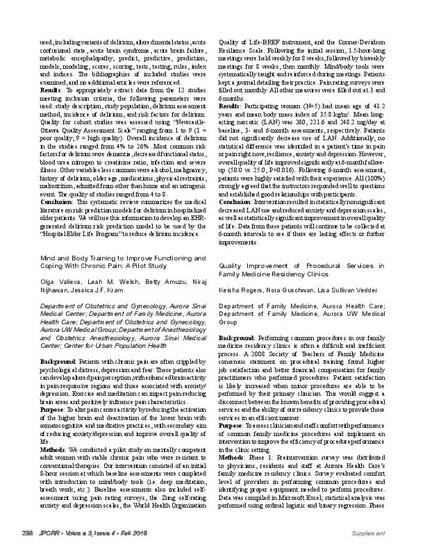
- chronic pain,
- exercise,
- meditation,
- anxiety,
- depression
Background: Patients with chronic pain are often crippled by psychological distress, depression and fear. These patients also can develop altered pain perception, with enhanced brain activity in pain-responsive regions and those associated with anxiety/depression. Exercise and meditation can impact pain-reducing brain areas and positively influence pain characteristics.
Purpose: To alter pain center activity by reducing the activation of the higher brain and deactivation of the lower brain with somatocognitive and meditative practices, with secondary aim of reducing anxiety/depression and improve overall quality of life.
Methods: We conducted a pilot study on mentally competent adult women with stable chronic pain who were resistant to conventional therapies. Our intervention consisted of an initial 8-hour session at which baseline assessments were completed with introduction to mind/body tools (i.e. deep meditation, breath work, etc.). Baseline assessments also included self-assessment using pain rating surveys, the Zung self-rating anxiety and depression scales, the World Health Organization Quality of Life-BREF instrument, and the Conner-Davidson Resilience Scale. Following the initial session, 1.5-hour-long meetings were held weekly for 8 weeks, followed by biweekly meetings for 8 weeks, then monthly. Mind/body tools were systematically taught and reinforced during meetings. Patients kept a journal detailing their practice. Pain rating surveys were filled out monthly. All other measures were filled out at 3 and 6 months.
Results: Participating women (N = 5) had mean age of 43.2 years and mean body mass index of 35.8 kg/m2. Mean long-acting narcotic (LAN) was 260, 221.6 and 248.2 mg/day at baseline, 3- and 6-month assessments, respectively. Patients did not significantly decrease use of LAN. Additionally, no statistical difference was identified in a patient’s time in pain or pain right now, resilience, anxiety and depression. However, overall quality of life improved significantly at 6-month follow-up (50.0 vs 25.0, P = 0.016). Following 6-month assessment, patients were highly satisfied with their experience. All (100%) strongly agreed that the instructors responded well to questions and established good relationships with participants.
Conclusion: Intervention resulted in statistically nonsignificant decreased LAN use and reduced anxiety and depression scales, as well as statistically significant improvement in overall quality of life. Data from these patients will continue to be collected at 6-month intervals to see if there are lasting effects or further improvements.
Valieva O, Welsh LM, Amuzu B, Nijhawan N, Kram JJ. Mind and body training to improve functioning and coping with chronic pain: a pilot study. J Patient Cent Res Rev. 2016;3:238.
